
Related
Topics
Guests
- Richard Feldmanformer autoworker and longtime community and labor activist here in Detroit. He is a board member of the James and Grace Lee Boggs Center.
To talk more about the history of the auto industry, I spoke with Richard Feldman last night. We met outside the former Packard car plant. Rich is a former autoworker and longtime community and labor activist here in Detroit. He is a board member of the James and Grace Lee Boggs Center. [includes rush transcript]
Transcript
AMY GOODMAN: We are on the road in Detroit. I’m Amy Goodman. To talk more about the history of the auto industry, I spoke with Rich Feldman last night. Actually, he took us on a tour of Detroit. We met outside the former Packard car plant. Rich is a former auto worker, longtime community and labor activist here in Detroit, board member of the James and Grace Lee Boggs Center.
RICHARD FELDMAN: My name is Rich Feldman, and we’re here at the Packard plant on Mount Elliott and East Grand Boulevard in Detroit, Michigan. And we’re here because it’s the space and, if you look around, the place that you can get a sense of what happened in the twentieth century. You can get a sense of the size of what it meant to be in the center of the Industrial Age, and you can also get a sense of the pain and the destruction that’s taken place as the twentieth century ended. So I come here as I do tours, and I do a lot of tours for folks, as we come around, as people visit Detroit, especially with the US Social Forum coming here or the Allied Media Conference this week, as a way to talk about history, as a way to talk about what the Industrial Age has meant, what it meant to be in Detroit. And Detroit is really not only the epicenter of the crisis and the pain, but also, as we’ll talk later on, the epicenter of a tremendous amount of hope and rejuvenation taking place.
AMY GOODMAN: So tell us about this building.
RICHARD FELDMAN: This is a Packard plant, and the Packard plant was Packard Motors. And it was built and designed by Albert Kahn, and it’s the first building that had support structured steel and metal going through all the facility to make it last as long as it has. And it was opened in 1906, so we’re talking 104 years ago. And Packard Motors was a company that produced luxury cars. And to get a sense, Detroit, being the home of the automobile and the assembly line, was a place where factories like this were being built and tens of thousands of workers would be working every day. It’s a building. It has fifty buildings. It’s the size of seven Cobo Halls, where the US Social Forum will be. It used to have 11,000 workers here every day and 11,000 workers a day making a good living, taking parts and being a parts assembly facility, assembling automobiles, engines for Packard Motors. Eventually, during the war, it was a facility that made it engines for Mercedes for the war effort. And it closed in 1956. So we’re talking, it’s been closed —-
AMY GOODMAN: Half-a-century.
RICHARD FELDMAN: Half-a-century. And it’s still standing. So from '56 onward, it was used as small factories and small storage places. And the way the story goes, in the ’90s it was used for rave parties. And then Mayor Archer said he was going to tear it down and do something, so they pushed all the small businesses out and small factories and small warehouses out, and it’s been abandoned for the last ten or fifteen years. And on a daily basis, people come here and will take, if you look over there, will take some of the steel and scrap, to the point where some of the walls will just come tumbling down.
But I come here because it's a way to talk about the history and to understand that the auto industry was the motor of the twentieth century of the economic American dream; to understand that in the 1930s at the Ford Rouge plant there was 100,000 workers under one roof, and now, within the United Auto Workers, there are fewer than 100,000 GM, Ford and Chrysler workers; so, to understand how much the country was changing, going from agriculture to industry, and giving people a way of life that they thought would go on forever -— we thought would go on forever. But I come here because it also shows the amazing pain, when you look — you know, it just — and the pain of not just during the times that it was successful, but what’s left. And the auto industry, to get a little sense of the auto industry is to understand that Detroit was once a million people in the turn-of-the-century, it goes up to two million in 1950, and now is down to about 850,000. And one-third of the city is now vacant land.
AMY GOODMAN: So, tell us where we’re going, Rich.
RICHARD FELDMAN: We’re driving from the Packard plant to the GM Poletown plant, and we’re going up East Grand Boulevard, which is the boulevard that goes from the east side to the west side and was once the border of Detroit, before Detroit expanded to 8 Mile.
AMY GOODMAN: And 8 Mile is?
RICHARD FELDMAN: And 8 Mile is the divide between Detroit and the suburbs. When you look around here at the Poletown plant, it’s so important to understand that this was the belief that this Poletown plant would be the hopes and the dreams of continuing the economic American dream of autoworkers becoming middle class, and the fact that our standard of living went up and up and up.
And I come here because it’s a way to talk about Detroit history and to understand, in 1980, this area had some 5,000 people living here, some 3,500 homes, 115 businesses, churches and hospitals. And what happened was, during the '80s — to understand the auto industry, you have to go back to the OPEC, the development of OPEC in 1973, 1974. From 1945 to 1973 and 1974, the US has a full monopoly — GM, Ford and Chrysler, essentially — of auto production in the United States and auto sales in the United States. And to understand that after World War II, Germany and Europe and Japan are totally devastated, so we're the only ones that survive as a nation, and therefore the only ones producing automobiles. In '73, end of ’73, OPEC happens. The Oil Petroleum Economic Conglomerate comes together, and they say, “We want some of these resources. We want some of the oil. You can’t just take it at whatever price you want.” And I remember paying 22 cents a gallon before then, and we all know what we pay now. But what they were really saying is, the rest of the world, it was their turn to get some of their resources back. The other thing that was happening by the late ’70s is Japan and Germany and Europe were beginning to make their own cars, and they were beginning to sell their cars in the United States. And so, there began to be competition for the first time. So that moment in American history, from ’45 to ’73 and ’78, is sort of the American century, where we believe this is how it's going to be forever.
And Coleman Young was the mayor who gets elected in 1973, was a friend of radicals, was a friend of the — was an active union supporter, was a friend of the Communist Party, very progressive guy, believed that he could bring back jobs to Detroit. And how significant his election was, we have to take a moment back, because before his election, Detroit had gone from being a predominantly white population to an increasing, growing majority African American population. And in 1967, we had the Detroit Rebellion. And the Detroit Rebellion happened for two fundamental reasons. It happened, one, because young people began to recognize that there would be no jobs for them, and two, because the white occupation army that had been brutalizing and killing citizens, African Americans in Detroit was totally out of control, and people responded to that. And we’re very clear that that was a rebellion, not a riot. We had a riot in 1943, where African Americans were killed. This was a rebellion against where the city was going, where the country was going. And out of that comes the election of Coleman Young, and it was a great victory to have the first African American mayor elected in the city of Detroit. It meant that, for the first time, the occupation army would be transformed. It meant that African Americans would have a chance to be in charge of the schools, in charge of the administration of the city, and so forth and so on.
AMY GOODMAN: When you say “occupation army,” do you mean the police?
RICHARD FELDMAN: I mean the police. The police were — would run rampant through the communities during that time.
AMY GOODMAN: And you said that Dr. Martin Luther King had an office here in 1963?
RICHARD FELDMAN: Well, in 1963, Martin Luther King, before he gave his “I Have a Dream” speech in Washington, came to Detroit on June 19th and gave basically the same speech. And it was organized by Reverend Cleage, Reverend Franklin, and the United Auto Workers was very much part of it in providing an office for Martin Luther King to organize the march. And it clearly was a historic moment in 1963 for that march to go. There was 250,000 people going down Woodward Avenue for that march.
AMY GOODMAN: And he uttered those words, “I have a dream”?
RICHARD FELDMAN: Yes, yes. He did the “I Have a Dream” moment in Detroit first.
AMY GOODMAN: And didn’t Malcolm X also come here in 1965?
RICHARD FELDMAN: Malcolm X was here at King Solomon Baptist Church, because after the ’63 march, you begin to have the civil rights movement and the Black Power movement go through splits, and Malcom X came here and gave the Grassroots Leadership “Message to the Grassroots” at King Solomon Baptist Church, which is right near Hush House, which is now an area being rebuilt and reclaimed by the community with urban gardens and parks. And the minister from King Solomon Baptist Church will be speaking at the labor rally on Friday here in Detroit. And Malcolm — so the history of Martin and Malcolm in Detroit is obviously important.
AMY GOODMAN: That was Rich Feldman, longtime community and labor activist here in Detroit. Special thanks to Jacquie Soohen of Big Noise Films and Nicole Salazar.
We’ll be broadcasting for the next two days from the US Social Forum, and then we’ll be broadcasting from Toronto on Friday, where the G-20 summit is taking place. Thousands are expected to protest outside. I’ll be speaking at a benefit for the Toronto community radio station CIUT on Saturday night, 7:00 p.m. at Trinity St. Paul’s United Church on Bloor Street. For more info, you can go to ourwebsite at democracynow.org.

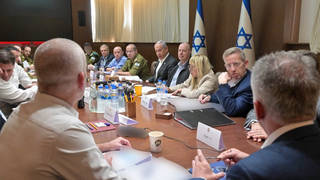
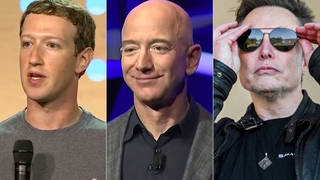
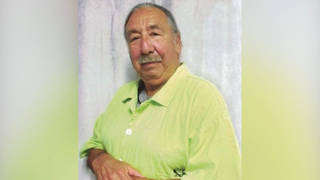

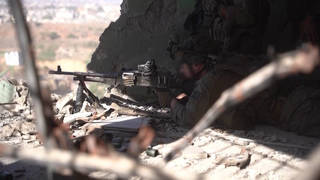




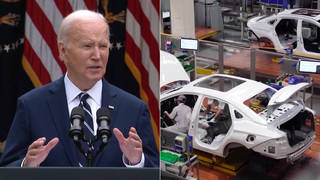
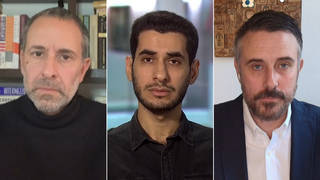
Media Options